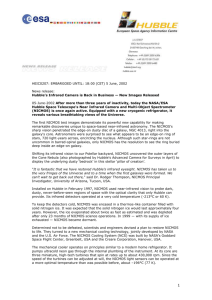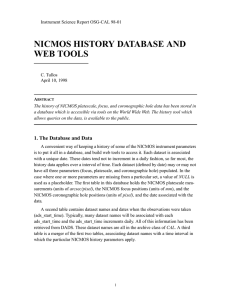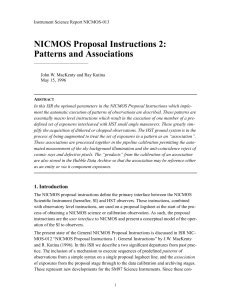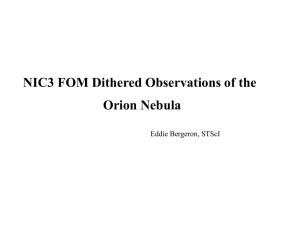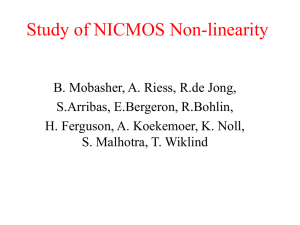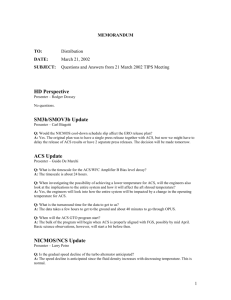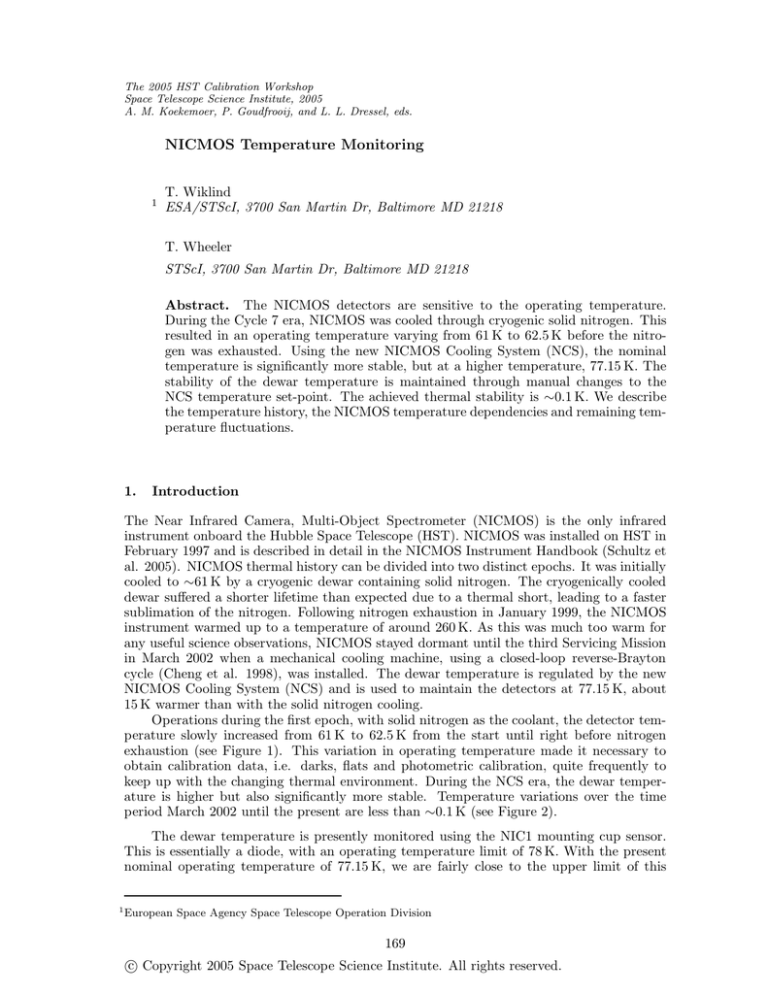
The 2005 HST Calibration Workshop
Space Telescope Science Institute, 2005
A. M. Koekemoer, P. Goudfrooij, and L. L. Dressel, eds.
NICMOS Temperature Monitoring
1
T. Wiklind
ESA/STScI, 3700 San Martin Dr, Baltimore MD 21218
T. Wheeler
STScI, 3700 San Martin Dr, Baltimore MD 21218
Abstract. The NICMOS detectors are sensitive to the operating temperature.
During the Cycle 7 era, NICMOS was cooled through cryogenic solid nitrogen. This
resulted in an operating temperature varying from 61 K to 62.5 K before the nitrogen was exhausted. Using the new NICMOS Cooling System (NCS), the nominal
temperature is significantly more stable, but at a higher temperature, 77.15 K. The
stability of the dewar temperature is maintained through manual changes to the
NCS temperature set-point. The achieved thermal stability is ∼0.1 K. We describe
the temperature history, the NICMOS temperature dependencies and remaining temperature fluctuations.
1.
Introduction
The Near Infrared Camera, Multi-Object Spectrometer (NICMOS) is the only infrared
instrument onboard the Hubble Space Telescope (HST). NICMOS was installed on HST in
February 1997 and is described in detail in the NICMOS Instrument Handbook (Schultz et
al. 2005). NICMOS thermal history can be divided into two distinct epochs. It was initially
cooled to ∼61 K by a cryogenic dewar containing solid nitrogen. The cryogenically cooled
dewar suffered a shorter lifetime than expected due to a thermal short, leading to a faster
sublimation of the nitrogen. Following nitrogen exhaustion in January 1999, the NICMOS
instrument warmed up to a temperature of around 260 K. As this was much too warm for
any useful science observations, NICMOS stayed dormant until the third Servicing Mission
in March 2002 when a mechanical cooling machine, using a closed-loop reverse-Brayton
cycle (Cheng et al. 1998), was installed. The dewar temperature is regulated by the new
NICMOS Cooling System (NCS) and is used to maintain the detectors at 77.15 K, about
15 K warmer than with the solid nitrogen cooling.
Operations during the first epoch, with solid nitrogen as the coolant, the detector temperature slowly increased from 61 K to 62.5 K from the start until right before nitrogen
exhaustion (see Figure 1). This variation in operating temperature made it necessary to
obtain calibration data, i.e. darks, flats and photometric calibration, quite frequently to
keep up with the changing thermal environment. During the NCS era, the dewar temperature is higher but also significantly more stable. Temperature variations over the time
period March 2002 until the present are less than ∼0.1 K (see Figure 2).
The dewar temperature is presently monitored using the NIC1 mounting cup sensor.
This is essentially a diode, with an operating temperature limit of 78 K. With the present
nominal operating temperature of 77.15 K, we are fairly close to the upper limit of this
1
European Space Agency Space Telescope Operation Division
169
c Copyright 2005 Space Telescope Science Institute. All rights reserved.
170
Wiklind & Wheeler
sensor. Should the temperature increase, alternate means of measuring the detector temperatures becomes necessary. One possibility is to use the bias obtained during dark observations. This avenue of monitoring the temperature is presently being explored (Bergeron,
in preparation).
2.
NICMOS temperature effects
The NICMOS detectors show a number of effects that are sensitive to temperature. It is
therefore of utmost importance to maintain the thermal environment as stable as possible
over long time scales. Any variation of the detector temperature will require a substantial
calibration effort.
The temperature in the dewar depends on several factors, the NCS neon cooling capacity and set-point (the neon temperature in the closed-loop is maintained at ∼72 K and can
be adjusted to achieve a desirable detector temperature), and several sources of ’parasitic’
heat loading:
• Annual cycle. The heat load on HST varies with the Sun distance, with the warmest
period in January and the coldest in June. This is seen as a slow change in the average
dewar temperature if a constant NCS cooling set-point temperature is maintained.
• Day/Night Cycle. Moving from direct sunlight to night changes the heat loading
on HST. The time scale is short enough that the NICMOS dewar does not respond
quickly. The day/night cycle does, however, provide a thermal driving force which
can be detected in the detector temperature.
• HST Sun/Roll Angle. The HST sun/roll angle determines which part of the HST aft
shroud is in direct sun light. Prolonged pointings can cause more or less heat loading
on the NICMOS dewar, with temperature effects of the order 0.1 K on time scales of
several days.
• NICMOS Operation. Use of the NICMOS detectors, whether for science operations,
calibrations or autoreset mode, affect the detector temperature.
• Other Aft Shroud Instruments. Instruments other than NICMOS can cause heat
loading inside the aft shroud and thereby affect the NICMOS detector temperature
on short time scales. This is, however, a relatively small effect.
• Autoreset Mode. When not used for science exposures, the NICMOS detectors are
continuously read out. The reason for this is to remove trapped charge caused by
passages through the South Atlantic Anomaly (see below). This causes a heat loading
on the NICMOS detectors, with small (<0.1 K) temperature jitter (see Figure 1).
The temperature response time of the NICMOS detectors is relatively long (∼120
minutes) due to the relatively large thermal mass of the dewar. However, the various
thermal loadings listed above induce detectable temperature fluctuations at the NICMOS
detectors. In Figure 3 we show three power spectral density (PSD) plots of the NIC1
mounting cup temperature sensor for a period of about two weeks during (a) pre-autoreset
mode in Cycle 7, with autoreset mode in Cycle 7, and with the NCS and autoreset mode
during Cycle 14. Four distinct periods are distinguishable in all three cases: ∼24 hours, 101
minutes, 49 minutes and 33 minutes. In addition there is a strong peak at ∼3.5 minutes
(Figure 4). The latter peak is not related to the temperature of the detector, but is likely
to be an artifact caused by the electronics involved in the temperature sensing itself. The
3.5 minute period is present in both pre-NCS and NCS data and is not affected by the
autoreset mode (see Figure 4).
NICMOS Temperature Monitoring
171
Figure 1: The dewar temperature at the NIC1 detector mounting cup during the period
February 1997 until the warm-up in January 1999. An almost linear increase in the temperature, from 61 K to 62.5 K can be seen. The warm-up in January 1999 was caused by
the exhaustion of the solid nitrogen supply. At the start of Cycle 7, the autoreset mode
(see text) was off. The start of autoreset is seen as an increase in the amplitude of the
temperature fluctuations.
The 24 hour period is related to passage through the South Atlantic Anomaly (SAA),
which occurs a few times every day and is associated with the deposit of a large amount of
charge in the NICMOS detectors. The 101, 49 and 33 minute periods are associated with
the orbital period of the HST and, hence, the day/night cycle. Other parasitic thermal
loadings are not of periodic nature and hence do not show up in the plot. Although the
sampling is too short to show the annual variation, it would be a very weak signal as the
setting of the neon temperature set-point is manually regulated to compensate for the slow
heating and cooling associated with the seasonal changes.
3.
Temperature effects on the NIMCOS detectors
The performance of the NICMOS detectors show several dependencies on temperature.
The four most important ones are (1) linear dark current, (2) detector quantum efficiency
(DQE), (3) the shading residual and (4) the saturation level.
1. The linear dark current increases linearly with exposure time (hence the name). It is a
residual after amplifier glow and shading have been removed. The dark current levels
of all three NICMOS cameras are stable, and does not exceed the values expected for
the new operating temperature. The increased operating temperature in the NCS era
has increased the number of ‘hot’ pixels, i.e. pixels with higher-than-average linear
dark current. This can, however, be accounted for by dithering NICMOS exposures.
2. The detector quantum efficiency (DQE) of the NICMOS detectors depends on the
temperature in the sense that the DQE has increased with the new higher operating
temperature. Pixels with a lower than average response (i.e. ‘hot’ pixels) show a
higher than average DQE increase with temperature, resulting in a flatter overall
response. The average response at 77.15 K increased by about 60% at J, 40% at H,
and 20% at K.
3. The NICMOS detectors exhibit a noiseless signal gradient orthogonal to the direction
of primary clocking, which is commonly referred to as shading. It is caused by changes
of the pixel bias levels as a function of temperature as well as time since the last
172
Wiklind & Wheeler
Figure 2: Same as Figure 1 but starting in March 2002 (top figure) when the NICMOS
Cooling System was installed. The bottom figure shows the dewar temperature between
November 2004 and November 2005. The red horizontal line is the nominal operating
temperature of 77.15 K.
NICMOS Temperature Monitoring
173
Figure 3: The Power Spectral Density (PSD) of temperature fluctuations at the NIC1
mounting cup for three different thermal epochs: pre-autoreset mode in Cycle 7 (green),
autoreset mode in Cycle 7 (red) and NCS with autoreset in Cycle 10-14 (blue). Peaks
corresponding to periodicities of ∼24 hours, 101, 49 and 33 minutes are seen in all three
epochs. The two first periods correspond to thermal driving from SAA passages and orbital
night/day, respectively. The last two periods are harmonics of the orbital periods. Notice
that the use of autoreset (autoflush) mode consistently gives a higher power spectral density. This corresponds to the extra thermal load imposed by the continuous reading of the
detectors while they are not in use for scientific exposures.
readout (∆-time). The shading can be completely removed during pipeline processing
once it has been calibrated with ∆-time and accurate detector temperature.
4. The saturation level, or dynamic range, of a given detector pixel is defined by the well
depth, i.e. the amount of charge loaded into the pixel during the detector reset. The
reset voltages of the NICMOS detectors vary with temperature. The pixel saturation
level will therefore also vary with temperature. For NIC1 and NIC2, the saturation
level is ∼15% lower when operating at 77.15 K than at 61 K, for NIC3, the difference
is only ∼7%.
4.
Summary
The NICMOS detectors show several effects which are temperature dependent. Although
most of these can be handled in the pipeline, successful data reduction requires accurate
knowledge of the detector temperature. The easiest way of assuring good data is to keep
a constant detector temperature, corresponding to the environment when calibration data
was obtained. In the NCS era this is achieved through monitoring of the NIC1 mounting
cup temperature sensor and manually changing the NCS neon temperature set-point. Since
the re-start of NICMOS in March 2002, we have achieved a temperature stability of ∼0.1 K.
Despite this, there are small scale temperature fluctuations on short time scales. These are
mainly caused by passages through the SAA, the orbital night/day cycle and intermittent
parasitic thermal loads. The autoreset mode, started in Cycle 7 to flush out trapped charges,
induces a small scale temperature jitter in the NICMOS detectors.
174
Wiklind & Wheeler
Cycle 7 pre−autoreset
Cycle 7 autoreset
Cycle 14 NCS
Figure 4: The Power Spectral Density (PSD) of temperature fluctuations at the NIC1
mounting cup for three different thermal epochs: pre-autoreset mode in Cycle 7, postautoreset mode in Cycle 7 and Cycle 14. The flat part of the frequency response corresponds
to white noise and the prominent peak at ∼4.8 mHz (corresponding to a periodicity of ∼3.5
minutes) is not related to thermal fluctuations, but an intrinsic electronic signal. The
periods seen in Figure 3 can be seen at the left. The curves have been offset along the
y-axis since they would otherwise overlap each other.
References
Cheng, E.S., Smith, R.C., Jedrich, N.M., Gibbon, J.A., Cottingham, D.A., Swift, W.L. &
Dame, R.E. 1998, SPIE Proc., 3356, 1149
Schultz, A., Noll, K., Barker, E., Arribas, S., Bergeron L. E., de Jong, R., Malhotra, S.,
Mobasher, B., Wiklind, T. & Xu, C., 2005, NICMOS Instrument Handbook, version
8. (Baltimore: STScI)

